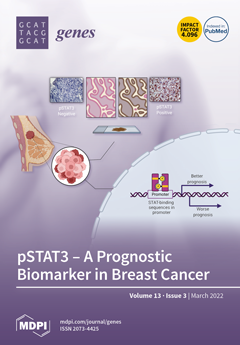Xeroderma pigmentosum (XP) is a rare autosomal recessive genetic disorder characterized by severe sensitivity of skin to sunlight and an increased risk of skin cancer. XP variant (XPV), a milder subtype, is caused by variants in the
POLH gene.
POLH encodes an error-prone
[...] Read more.
Xeroderma pigmentosum (XP) is a rare autosomal recessive genetic disorder characterized by severe sensitivity of skin to sunlight and an increased risk of skin cancer. XP variant (XPV), a milder subtype, is caused by variants in the
POLH gene.
POLH encodes an error-prone DNA-polymerase eta (pol eta) which performs translesion synthesis past ultraviolet photoproducts. The current study documents the clinical and genetic investigations of two large consanguineous Pakistani families affected with XPV. In family 1, whole exome sequencing (WES) revealed a novel frameshift variant, c.1723dupG (p.(Val575Glyfs*4)), of
POLH, which is predicted to cause frameshift and premature truncation of the encoded enzyme. Indeed, our ex vivo studies in HEK293T cells confirmed the truncation of the encoded protein due to the c.1723dupG variant. In family 2, Sanger sequencing of
POLH exons, revealed a recurrent nonsense variant, c.437dupA (p.Tyr146*). POLH forms a hetero-tetrameric POLZ complex with REV3L, REV7, POLD2 and POLD3. Next, we performed in silico analysis of
POLH and other POLZ complex genes expression in publicly available single cell mRNAseq datasets from adult human healthy and aging skin. We found overlapping expression of
POLH, REV3L and
POLD2 in multiple cell types including differentiated and undifferentiated keratinocytes, pericytes and melanocytes in healthy skin. However, in aging human skin,
POLH expression is reduced in compare to its POLZ complex partners. Insights from our study will facilitate counseling regarding the molecular and phenotypic landscape of
POLH-related XPV.
Full article






